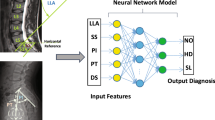Abstract
This study develops a logistic model tree based automation system based on for accurate recognition of types of vertebral column pathologies. Six biomechanical measures are used for this purpose: pelvic incidence, pelvic tilt, lumbar lordosis angle, sacral slope, pelvic radius and grade of spondylolisthesis. A two-phase classification model is employed in which the first step is preprocessing the data by use of Synthetic Minority Over-sampling Technique (SMOTE), and the second one is feeding the classifier Logistic Model Tree (LMT) with the preprocessed data. We have achieved an accuracy of 89.73 %, and 0.964 Area Under Curve (AUC) in computer based automatic detection of the pathology. This was validated via a 10-fold-cross-validation experiment conducted on clinical records of 310 patients. The study also presents a comparative analysis of the vertebral column data with the use of several machine learning algorithms.




Similar content being viewed by others
References
Bigos, S. J., United States. Agency for Health Care Policy and Research., Acute low back problems in adults, U.S. Dept. of Health and Human Services, Public Health Service. Agency for Health Care Policy and Research, Rockville, 1994.
NINDS, National Institute of Neurological Disorders and Stroke. Low-Back Pain Fact Sheet. http://www.ninds.nih.gov/disorders/backpain/detail_backpain.htm. Accessed March 3, 2013.
Langworthy, J. R., Evaluation of impairment related to low back pain. J. Med. Syst. 17:253–256, 1993.
J. P. Kostuik, S. Margolis, Low Back Pain and Osteoporosis, The John Hopkins White Paper on Low Back Pain and Osteoporosis, 2002.
Verdonck, B., Nijlunsing, R., Gerritsen, F. A., Cheung, J., Wever, D. J., Veldhuizen, A., Devillers, S., and Makram-Ebeid, S., Computer assisted quantitative analysis of deformities of the human spine. In: Wells, W., Colchester, A., and Delp, S. (Eds.), Medical Image Computing and Computer-Assisted Interventation — MICCAI’98. Springer, Berlin, pp. 822–831, 1998.
Herring, J. L., and Dawant, B. M., Automatic lumbar vertebral identification using surface-based registration. Journal of biomedical informatics 34(2):74–84, 2001.
Whitmarsh, T., Humbert, L., Del Rio Barquero, L. M., Di Gregorio, S., and Frangi, A. F., 3D reconstruction of the lumbar vertebrae from anteroposterior and lateral dual-energy X-ray absorptiometry. Med. Image Anal. 17:475–487, 2013.
Anitha, H., and Prabhu, G. K., Automatic Quantification of Spinal Curvature in Scoliotic Radiograph using Image Processing. J. Med. Syst. 36(3):1943–1951, 2012.
Alomari, R. S., Corso, J. J., Chaudhary, V., and Dhillon, G., Toward a clinical lumbar CAD: herniation diagnosis. International journal of computer assisted radiology and surgery 6(1):119–126, 2011.
Chamarthy, P., Stanley, R. J., Cizek, G., Long, R., Antani, S., and Thoma, G., Image analysis techniques for characterizing disc space narrowing in cervical vertebrae interfaces. Comput. Med. Imaging Graph. 28:39–50, 2004.
Berthonnaud, E., Dimnet, J., Roussouly, P., and Labelle, H., Analysis of the sagittal balance of the spine and pelvis using shape and orientation parameters. Journal of spinal disorders & techniques 18(1):40–47, 2005.
Rocha Neto, A., Sousa, R., Barreto, G. A., and Cardoso, J., Diagnostic of Pathology on the Vertebral Column with Embedded Reject Option. In: Vitrià, J., Sanches, J., and Hernández, M. (Eds.), Pattern Recognition and Image Analysis. Springer, Berlin, pp. 588–595, 2011.
Mattos, C. C., and Barreto, G., ARTIE and MUSCLE models: building ensemble classifiers from fuzzy ART and SOM networks. Neural Comput & Applic 22:49–61, 2013.
E. Abdrabou, A Hybrid Intelligent Classifier for The Diagnosis Of Pathology On The Vertebral Column. In Proc. of Intelligent Information and Engineering Systems INFOS 2012. In Print.
D. J. Newman, S. Hettich, C. L. Blake, C. J. Merz, UCI Repository of machine learning databases, University California Irvine, Department of Information and Computer Science,1998.
Roussouly, P., and Pinheiro-Franco, J. L., Biomechanical analysis of the spino-pelvic organization and adaptation in pathology. Eur. Spine J. 20(Suppl 5):609–618, 2011.
Legaye, J., Duval-Beaupere, G., Hecquet, J., and Marty, C., Pelvic incidence: a fundamental pelvic parameter for three-dimensional regulation of spinal sagittal curves. Eur. Spine J. 7:99–103, 1998.
Sergides, I. G., McCombe, P. F., White, G., Mokhtar, S., and Sears, W. R., Lumbo-pelvic lordosis and the pelvic radius technique in the assessment of spinal sagittal balance: strengths and caveats. Eur. Spine J. 20:591–601, 2011.
Chawla, N. V., Bowyer, K. W., Hall, L. O., and Kegelmeyer, W. P., SMOTE: synthetic minority over-sampling technique. Journal of Artificial Intelligence Research 16:321–357, 2002.
N.V. Chawla, C4.5 and Imbalanced Data sets: Investigating the effect of sampling method, probabilistic estimate, and decision tree structure. In ICMLWorkshop on Learning from Imbalanced Datasets II, 2003.
Landwehr, N., Hall, M., and Frank, E., Logistic Model Trees. Mach. Learn. 59:161–205, 2005.
Podgorelec, V., Kokol, P., Stiglic, B., and Rozman, I., Decision Trees: An Overview and Their Use in Medicine. J. Med. Syst. 26(5):445–463, 2002.
Breiman, L., Classification and regression trees. Wadsworth International Group, Belmont, 1984.
Friedman, J., Hastie, T., and Tibshirani, R., Additive logistic regression: a statistical view of boosting. Ann. Statist. 38(2):337–374, 2000.
M. Hall, E. Frank, G. Holmes, B. Pfahringer, P. Reutemann, I. H.Witten, The WEKA Data Mining Software: An Update; SIGKDD Explorations, 11(1) (2009).
Özçift, A., Random forests ensemble classifier trained with data resampling strategy to improve cardiac arrhythmia diagnosis. Computers in Biology and Medicine 41(5):265–271, 2011.
Pollettini, J. T., et al., Using machine learning classifiers to assist healthcare-related decisions: classification of electronic patient records. J. Med. Syst. 36(6):3861–3874, 2012.
Author information
Authors and Affiliations
Corresponding author
Additional information
This article is part of the Topical Collection on Systems-Level Quality Improvement
Rights and permissions
About this article
Cite this article
Karabulut, E.M., Ibrikci, T. Effective Automated Prediction of Vertebral Column Pathologies Based on Logistic Model Tree with SMOTE Preprocessing. J Med Syst 38, 50 (2014). https://doi.org/10.1007/s10916-014-0050-0
Received:
Accepted:
Published:
DOI: https://doi.org/10.1007/s10916-014-0050-0




